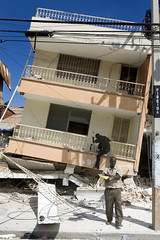 In the rush to save lives after the Haiti earthquake, Edward Brown, relief director for the Christian humanitarian organization World Vision, discusses how to handle some common misconceptions concerning disaster relief.
In the rush to save lives after the Haiti earthquake, Edward Brown, relief director for the Christian humanitarian organization World Vision, discusses how to handle some common misconceptions concerning disaster relief.Blankets, shoes, and clothing are not a cost-effective way to help
The cost of shipping these items from around the country—let alone the time it takes to sort, pack and ship them—is prohibitive and entails much higher cost than the value of the goods themselves. World Vision has relief supplies already stocked in disaster-prone countries as well as in strategically located warehouses around the world. World Vision had supplies pre-positioned in Haiti in preparation for hurricane season, which allowed the agency to respond immediately to last week's earthquake.
These supplies are designed to meet international standards for humanitarian relief and are packaged up and ready to deploy as soon as a crisis strikes. Cash donations are the best, most cost-effective way to help aid groups deliver these life-saving supplies quickly, purchase supplies close to the disaster zone when possible and replenish their stocks in preparation for future disasters.
Send cash, it will get there
Reputable agencies send 80 percent or more of cash donations to the disaster site; the rest is invested in monitoring, reporting and other activities that facilitate transparency and efficiency in their operations, as well as in sharing information with those who can help. Donors have a right and a responsibility to ask aid groups how they will be using those donations, and what will be done with donations raised in excess of the need. Transparent and effective organizations will readily provide that information.
Don't travel to volunteer unless you have specific disaster relief skills
While hands-on service may feel like a better way to help in a crisis, disaster response is a highly technical and sensitive effort. Professionals with specialized skills and overseas disaster experience should be deployed to disaster sites. Volunteers without those skills can do more harm than good, and siphon off critical logistics and translations services. Qualified disaster professionals ensure that help is delivered effectively, safely and efficiently.
Hasty international adoptions of children are not recommended
Hearing about the specific needs of children often sparks a desire to adopt children who seem to have lost their families. However, early in a crisis, children need to be protected, but should remain in their home countries until authorities can confirm the locations of their family members and explore adoption possibilities within their own communities and cultures. International adoption may be the best solution for some children, but it is too early to know for sure in the first weeks of a crisis.
People are resilient in the face of natural disasters
Even in the poorest countries like Haiti, people often reveal a great deal of inner strength and often show a resourcefulness that can save lives. While support and aid are necessary, the Haitian people are by no means helpless.
--------------
WHERE TO DONATE
For more information about how you can assist the Haiti relief effort, Charity Navigator, Google, and the Huffington Post have all assembled lists of organizations that are accepting donations and distributing aid.
[PHOTO CREDIT: United Nations Development Programme (CC).]







No comments:
Post a Comment